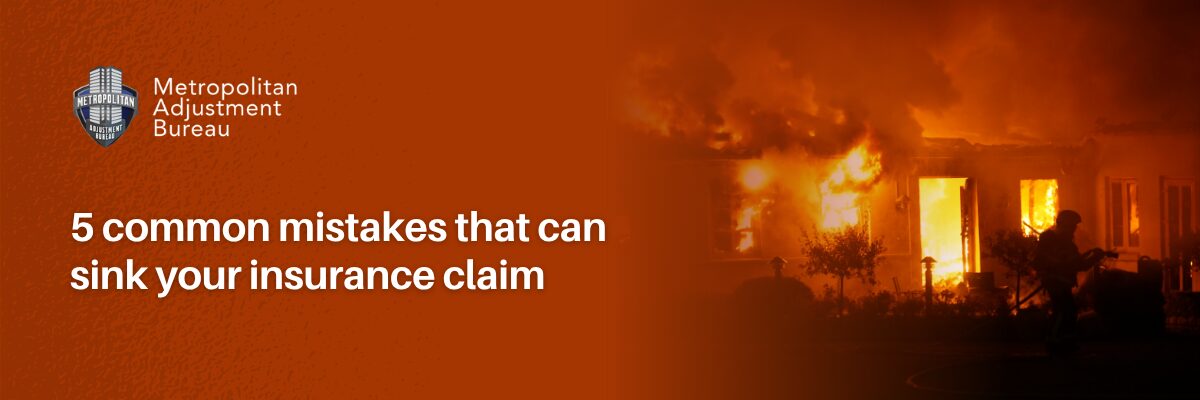California homeowners are facing more insurance stress than ever.
Wildfires, storms, and other disasters are happening with greater frequency, and insurers are tightening coverage, raising premiums, or pulling out of high-risk areas altogether.
When a loss does occur, many families are shocked to find their payout doesn’t come close to covering repairs.
The claims process is complicated — full of deadlines, policy fine print, and insurer scrutiny. Based on our experience, five mistakes account for most denied, delayed, or underpaid claims. Knowing what they are — and how to avoid them — can make the difference between rebuilding fully or struggling to recover.

Mistake 1: Lack of documentation
After a storm ripped shingles off a roof in Glendale, the family filed a claim with only a few blurry cell-phone photos. The insurer argued that hidden water damage wasn’t proven, and the payout came in thousands short.
How to avoid it:
- Take clear, dated photos and videos of all damage, inside and out
- Keep receipts, repair bills, and contractor estimates together
- Create a home inventory with serial numbers for electronics and appliances
Related question:
What documents do I need for a fire damage insurance claim?
Short answer: You’ll need a proof-of-loss statement, detailed photos or video, receipts for repairs or replacements, and a log of communications with your insurer. Read the full answer in our Fire Damage Insurance FAQ
Mistake 2: Policy exclusions and limitations
One homeowner was shocked to learn that her policy excluded smoke contamination even though her house was never touched by flames. She ended up paying out-of-pocket for HVAC cleaning and carpet replacement.
How to avoid it:
- Review your policy for smoke, soot cleanup, and code upgrade coverage
- Confirm whether you’re insured for replacement cost or actual cash value
- Ask if additional living expenses (ALE) are included
Related questions:
Does my policy cover smoke and soot cleanup?
Short answer: Most policies do, but insurers may dispute hidden contamination if it’s not visible. Full FAQ explanation here. See info on a recent lawsuit here.
Can I use ALE coverage for rent, meals, and clothes after a fire?
Short answer: ALE covers reasonable extra costs when your home is uninhabitable, including housing, meals, clothing, and transportation. See details in our Fire Damage Insurance FAQ
Mistake 3: Missed deadlines and filing errors
After a wildfire in Ventura County, one family waited months before sending their proof-of-loss form. By then, the insurer denied part of their claim because it was submitted late.
How to avoid it:
- Notify your insurer immediately after a loss
- Submit forms on time, including proof-of-loss statements
- Keep a running log of every call, email, and letter
Related question:
How long do I have to file a wildfire claim in California?
Short answer: Some policies require notice within 60 days, though California law allows two to three years for property damage claims after a declared emergency. Full explanation in our Fire Damage Insurance FAQ
Mistake 4: Low or inaccurate damage estimates
Insurers sometimes send out adjusters who prepare quick, surface-level estimates. In one case, a family in Pasadena was offered half the cost of rebuilding because the insurer didn’t account for code-required upgrades.
How to avoid it:
- Get independent estimates from licensed contractors
- Document hidden damage, such as smoke in walls or HVAC systems
- If possible, compare insurer figures with actual rebuild costs in your area
Related question:
What happens if my insurance payout isn’t enough to rebuild?
Short answer: This is underinsurance, a common issue after wildfires. Extended replacement coverage, supplemental funds, or legal remedies may help fill the gap. See the full answer in our Fire Damage Insurance FAQ
Mistake 5: Failure to mitigate further damage
A family in Altadena returned to their fire-damaged home but didn’t tarp their roof. When rain entered the structure, the insurer reduced their payout, arguing that the additional water damage could have been prevented.
How to avoid it:
- Take steps such as tarping roofs or boarding up windows
- Save receipts for emergency supplies and temporary repairs
- Photograph the mitigation work you perform
Related question:
Will my insurance cover debris removal after a wildfire?
Short answer: Yes, most policies cover debris removal, though county-run cleanup programs may coordinate directly with insurers and affect claim payouts. Read more in our Fire Damage Insurance FAQ
Protecting your claim from the start
Avoiding these mistakes gives you the strongest chance at a fair settlement. Insurance companies have professionals working for them. You deserve someone working for you.
Need help protecting your claim?





